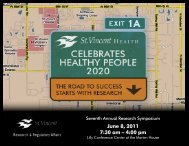Making Data Talk: A Workbook - National Cancer Institute
Making Data Talk: A Workbook - National Cancer Institute
Making Data Talk: A Workbook - National Cancer Institute
- No tags were found...
Create successful ePaper yourself
Turn your PDF publications into a flip-book with our unique Google optimized e-Paper software.
Communicate health findings with words by usingdifferent methodsText labels. Use words to label parts of your graphs, tables, and charts, and make sure the labels are placedclose to the data presented. When possible, use labels next to trend lines or clustered bars instead of furtheraway in a legend. Use language that is familiar to readers. You do not want to detract from the reader’s abilityto build knowledge or make health-related decisions, so strive to minimize clutter.Verbal qualifiers. Does your situation lend itself to using everyday terms to describe the relationship betweennumbers? If so, it may be suitable to use expressions such as “much higher,” “low risk,” or “most of the time.” 19Keep in mind, however, that your audience may misinterpret the meaning of these phrases. Additionally, individualsmay vary in the way they interpret your messages. One way to reduce the possibility of misinterpretation is toground or anchor verbal qualifiers with the actual numbers of interest. For example, “the chances of X are low; only5% or 5 in 100 people experience it.”Metaphors. Metaphors can help statistics “come to life.” 20 Equate numbers or rates to something your audiencecan relate to, such as the number of people that can be seated in a sports stadium, the number of children attendingthe average elementary school, or the number of people that live in an entire city or town. When writing forpeople in a specific locality/geographic area, consider personalizing the data by naming familiar venues, schools,or communities.Narratives. Narrative is another tool for bringing data to life. When possible, take your audience to anotherplace by telling the story with words, visual images, or both. Do you want to educate or persuade? Determinewhen it is best to use a short narrative, such as an anecdote, quotation, specific example, vignette, personal storyor testimonial, or case study. Consider using a longer narrative, such as an essay, short story, book, or some typeof script. While there are theoretical reasons for using narratives, the practical reasons are people’s preferencefor narratives or stories, the difficulty some have understanding standard data presentation formats, and the waynarratives are processed by the mind.Tips for communicating findings directly with numbersNumbers are best used to communicate findings when there is a need to be precise and concise. Numbers canbe used to show various types of values. Research shows that communicators should remember the followingtips and rules when using numbers:To instruct and inform◆ Most people have low levels of quantitative literacy. Keep numbers simple in nature, and giveeasy-to-understand modifiers to add meaning. Round most decimals to the nearest whole number(e.g., 9.6 is rounded to 10).◆ When writing for the Web, use actual numbers (2), versus words (two), even at the beginning of asentence. Use numbers to the billions (2,000,000,000), but use a combination of numbers andwords for higher numbers (2 trillion, not two trillion).◆ When possible, pre-test the use of numbers with your audience to ensure that the numbers are clear.17





